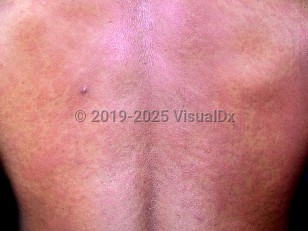Human immunodeficiency virus primary infection
Alerts and Notices
Important News & Links
Synopsis

Primary human immunodeficiency virus infection (PHI) syndrome, also called acute retroviral syndrome and seroconversion disease, is an acute mononucleosis-like illness that develops anywhere from 1-6 weeks following exposure to human immunodeficiency virus (HIV). Acute HIV infection, according to the Fiebig classification, is the period between viral acquisition and the emergence of HIV-specific antibodies. This period is associated with a high viral load. Patients with PHI syndrome may be asymptomatic or they can present with a variety of nonspecific symptoms and signs. A high index of suspicion is needed to make the diagnosis.
PHI syndrome is believed to occur in 50%-66% of newly infected individuals. Symptoms are variable; fever, headache, lymphadenopathy, nausea, diarrhea, rash, and pharyngitis are usually present. Other symptoms include vomiting, arthralgias, and photophobia. Rarely, neurological symptoms and hepatosplenomegaly are seen. Symptoms usually resolve within 15 days.
The rash is characteristically a morbilliform truncal exanthem that may resemble an exanthematous drug eruption or a viral exanthem. The palms and soles are usually spared. An enanthem with erythema and oral ulcers may be seen in more than half of patients with the syndrome. Genital ulcers are seen in around one-third.
PHI is important to recognize from a public health perspective. Patients with PHI are 10 times more likely to transmit HIV compared with patients in the chronic phase of HIV infection. Patients with PHI syndrome are most likely to present to primary care physicians, emergency rooms, urgent care and walk-in centers, or general medicine clinics. Approximately 90% of cases are not diagnosed at the primary encounter.
Related topics: acquired immune deficiency syndrome, HIV/AIDS-related pruritus, HIV-associated lung disease, human immunodeficiency virus disease, papular pruritic eruption of HIV
PHI syndrome is believed to occur in 50%-66% of newly infected individuals. Symptoms are variable; fever, headache, lymphadenopathy, nausea, diarrhea, rash, and pharyngitis are usually present. Other symptoms include vomiting, arthralgias, and photophobia. Rarely, neurological symptoms and hepatosplenomegaly are seen. Symptoms usually resolve within 15 days.
The rash is characteristically a morbilliform truncal exanthem that may resemble an exanthematous drug eruption or a viral exanthem. The palms and soles are usually spared. An enanthem with erythema and oral ulcers may be seen in more than half of patients with the syndrome. Genital ulcers are seen in around one-third.
PHI is important to recognize from a public health perspective. Patients with PHI are 10 times more likely to transmit HIV compared with patients in the chronic phase of HIV infection. Patients with PHI syndrome are most likely to present to primary care physicians, emergency rooms, urgent care and walk-in centers, or general medicine clinics. Approximately 90% of cases are not diagnosed at the primary encounter.
Related topics: acquired immune deficiency syndrome, HIV/AIDS-related pruritus, HIV-associated lung disease, human immunodeficiency virus disease, papular pruritic eruption of HIV
Codes
ICD10CM:
B20 – Human immunodeficiency virus [HIV] disease
SNOMEDCT:
111880001 – Acute HIV infection
B20 – Human immunodeficiency virus [HIV] disease
SNOMEDCT:
111880001 – Acute HIV infection
Look For
Subscription Required
Diagnostic Pearls
Subscription Required
Differential Diagnosis & Pitfalls

To perform a comparison, select diagnoses from the classic differential
Subscription Required
Best Tests
Subscription Required
Management Pearls
Subscription Required
Therapy
Subscription Required
References
Subscription Required
Last Reviewed:01/14/2019
Last Updated:01/16/2020
Last Updated:01/16/2020
 Patient Information for Human immunodeficiency virus primary infection
Patient Information for Human immunodeficiency virus primary infection
Premium Feature
VisualDx Patient Handouts
Available in the Elite package
- Improve treatment compliance
- Reduce after-hours questions
- Increase patient engagement and satisfaction
- Written in clear, easy-to-understand language. No confusing jargon.
- Available in English and Spanish
- Print out or email directly to your patient
Upgrade Today

Human immunodeficiency virus primary infection

